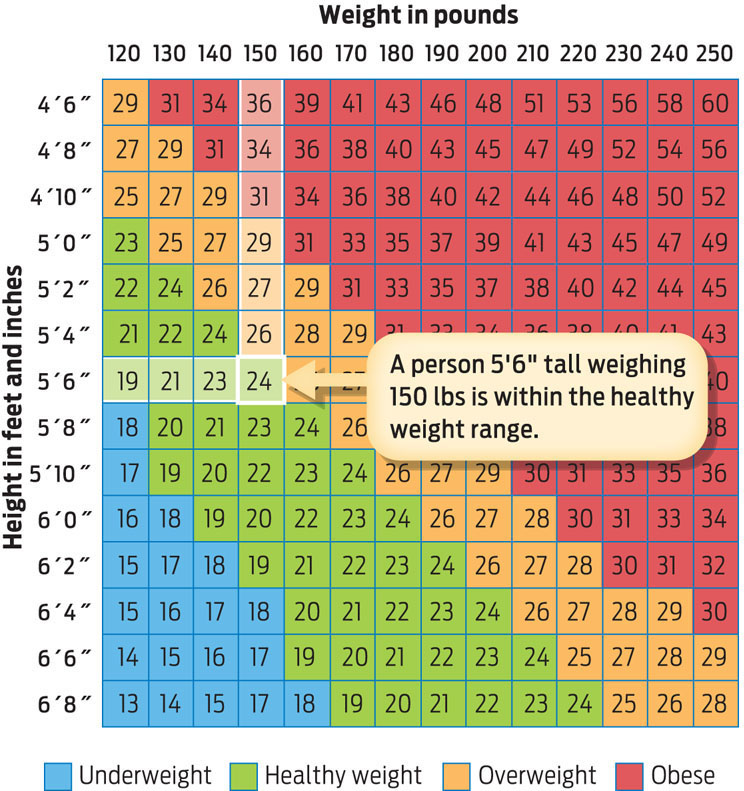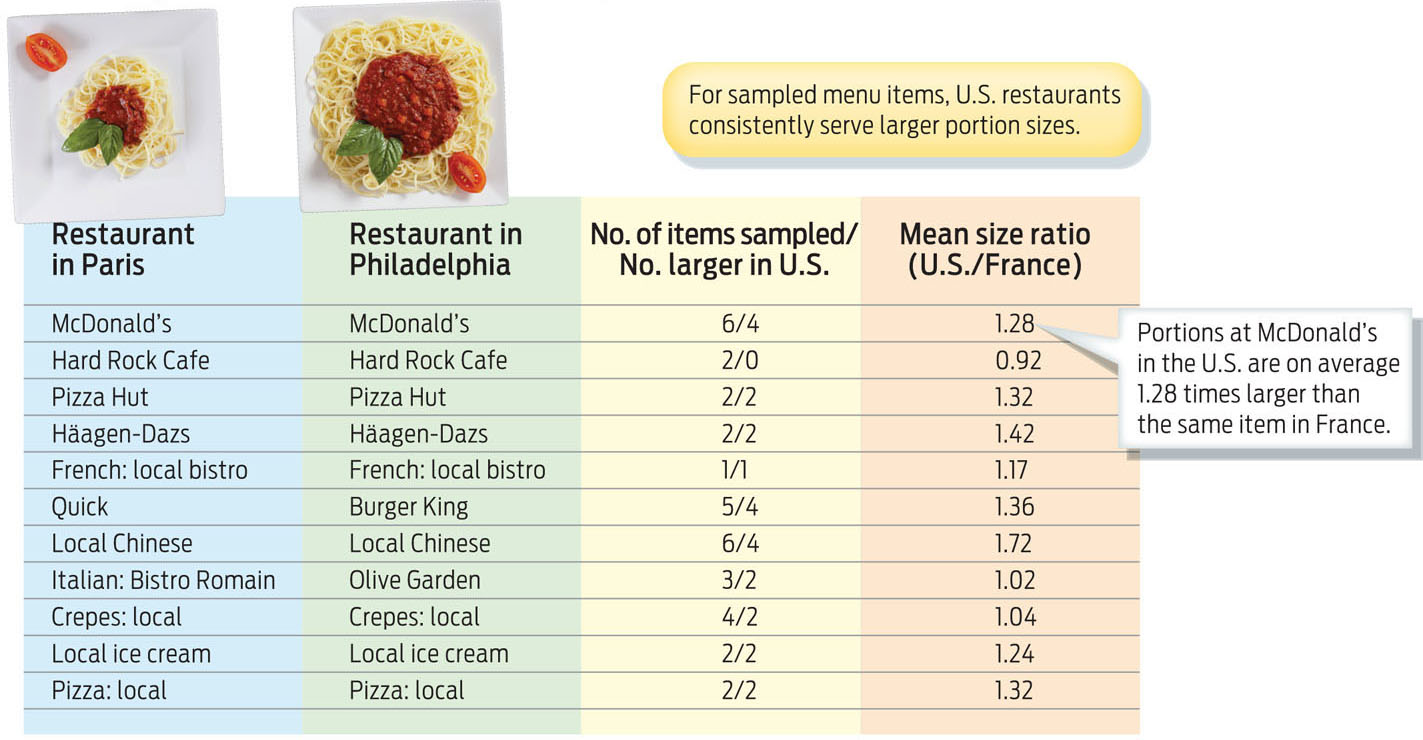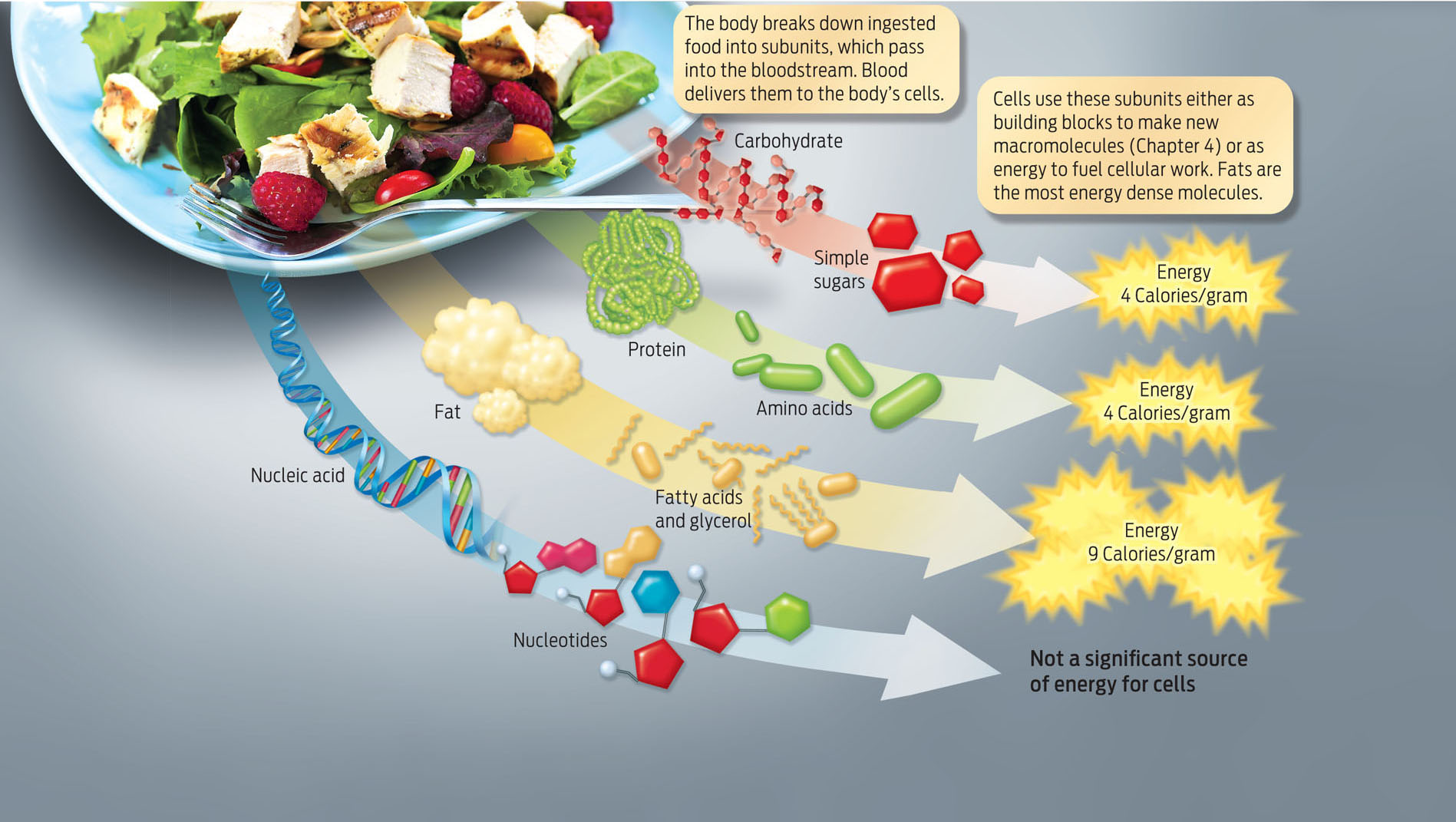The Size of the Problem
BODY MASS INDEX (BMI) An estimate of body fat based on height and weight.
OVERWEIGHT Having a BMI between 25 and 29.9.
OBESE Having 20% more body fat than is recommended for one’s height, as measured by a body mass index equal to or greater than 30.
Though the terms “overweight” and “obese” are used casually in popular culture, they actually have specific meanings in scientific circles. They are based on a tool called the body mass index (BMI). The BMI estimates body fat from the indirect measures of height and weight, and translates it into an easy-to-digest number. People with a BMI between 25 and 29.9 are considered overweight; people with a BMI of 30 and above are considered obese.
BMI provides a rough estimate of healthy and unhealthy amounts of body fat, and is useful as a general guide to weight. However, it can sometimes be misleading. Athletes and other people with more muscle mass, for example, will sometimes register as overweight when in fact they are a perfectly healthy weight (INFOGRAPHIC 6.2) .

118
Even with a few extra pounds here and there, most people still fall within a healthy weight range. Only when our total body fat passes a certain point do the scales tip toward unhealthy. That exact tipping point is the subject of much current research, and there are still many questions and controversies about the exact relationship between health and body fat. For example, is it possible to be fat and relatively healthy? Probably. Does being skinny necessarily mean you are in good cardiovascular health? No. Nevertheless, the preponderance of evidence suggests that there are real health risks to obesity, which is why some researchers have even referred to a global “obesity epidemic.”
To get at why Americans are rounding out while their food-loving French counterparts aren’t, Rozin and colleagues at the Centre National de la Recherche Scientifique in France decided to look at portion size. In 2003, the team set out to see if Americans do indeed eat more than the French. They compared portion sizes at 11 restaurants in Philadelphia, Pennsylvania, and in Paris, France. Their results, published in the journal Psychological Science, were revealing. The average portion size in the Paris restaurants weighed 277 g. By contrast, the average portion size in the Philadelphia restaurants weighed 346 g-25% more. Even restaurant chains in France like McDonald’s served smaller portions of certain foods: in Paris, medium fries weighed 90 g, large fries 135 g; in Philadelphia, medium fries weighed 155 g and large fries 200 g.
Once they had surveyed the restaurant scene, Rozin’s team went further. They compared the sizes of packaged food in American and in French supermarkets, and they found the same trend: the portions of the majority of food items they tested—from ice cream to chewing gum to yogurt—were smaller in France. Even portion sizes for ingredients in the most commonly used French cookbook were smaller than those in the American favorite, Joy of Cooking (INFOGRAPHIC 6.3) .
Researchers compared portion sizes in restaurants in Philadelphia, U.S., to those in Paris, France. In all but one restaurant, U.S. portions were larger at least half the time. The average portion size in Paris was 277 g; the average size in Philadelphia was 346 g. Philadelphians eat an average of 25% more food than Parisians at every meal.

SOURCE: Data from Rozin, P., et al. (2003) The ecology of eating: smaller portion sizes in France than in the United States help explain the French paradox. Psychological Science 14:450–454.
119

That portion size plays a role in weight gain seems pretty obvious: the more we eat, the heavier we get. But why does eating food lead to weight gain? After all, it’s not as if we simply increase in weight by the same number of pounds we put on our plate, so something else must be at work. We’ve already seen, in Chapter 4, that all food consists of mixtures of carbohydrates, fats, proteins, and nucleic acids, and that the relative proportion of each macronutrient varies in different types of food. Meat, for example, contains more protein per unit weight than do potatoes; potatoes have more carbohydrates than meat does. To nourish our bodies, we must eat a balanced diet that includes appropriate amounts of all macronutrients.
calorie The amount of energy required to raise the temperature of 1 g of water by 1°C.
But food is not only a source of nutrition; it is also a source of energy—the power to do work. Much in the same way that gasoline powers our cars, food supplies us with chemical energy that our bodies “burn” to power our activities. Food is fuel.
Calorie 1,000 calories or 1 kilocalorie (kcal); the capital “C” in Calorie indicates “kilocalorie.” The Calorie is the common unit of energy used in food nutrition labels.
The energy in food comes originally from the sun. Photosynthesizers such as plants capture the energy of sunlight and convert it into chemical energy stored in sugar (see Chapter 5). When we eat this sugar (or eat animals that have eaten this sugar), that stored energy becomes available to us. Not only that, but the energy in food, like all energy, obeys the principle of conservation of energy—energy is never destroyed, it only changes form—a fact with lasting consequences for our waistlines.
Scientists measure food energy in units called calories. A calorie (in lower case) is the amount of energy required to raise the temperature of 1 g of water by 1°C (1 degree Celsius). In essence, a calorie is a measurement of energy—the capacity to perform a certain amount of work. On most food labels, the amount of energy stored is listed in kilocalories, which are also referred to as kcals or Calories (the capital “C” indicates kilocalories, not calories). One Calorie is equal to 1,000 calories, or 1 kcal.
Different foods contain different amounts of energy, and therefore allow us to perform different amounts of work. Of all the organic molecules, fats are the most energy dense: each gram of fat stores approximately 9 Calories in its chemical bonds. Proteins and carbohydrates are about half as energy dense: about 4 Calories per gram. Clearly, a 200-g serving of fatty bacon contains many more Calories than does a 200-g serving of asparagus (INFOGRAPHIC 6.4) .
Food contains the macromolecules that provide the building blocks to make molecules critical to cell function. The subunits released from digested food can also be used as sources of energy for cells.

120
All our activities—everything from thinking and digesting to sleeping and running—require energy. So all bodies expend some Calories each day just to stay alive. A person’s daily energy needs largely depend on gender, age, body type, and activity levels. A sedentary college-age average-size male, for example, would need to ingest anywhere between 2,200 and 2,400 Calories per day to power his activities and maintain his weight, whereas a football player would need more than 3,200 Calories a day to power and maintain his. Exercise or other physical activities require additional energy beyond the basic life-sustaining energy needs of the body. Consequently, athletes, or those who exercise a great deal, generally need to eat more to fuel their activities than do their less-active peers.
Exactly how much more should an athlete eat? Consider the college football player, who must consume 800 to 1,000 Calories more than his sedentary roommate. An average cheeseburger contains anywhere between 400 and 600 Calories depending on its size, so the football player would need about two extra cheeseburgers per day. That’s probably less than you thought. Now suppose that same athlete ate a cheeseburger off-season. It would take 1.5 hours of slow swimming, or 2.5 hours of walking, or 3 hours of cycling at 5.5 miles per hour, to burn those extra Calories (TABLE 6.1) .

121
Perhaps not surprisingly, not everyone burns Calories at the same rate. There are people who seem to be able to eat to their heart’s content and remain slim. And there are those who seem to gain weight just by looking at food. Genetics plays a large role in how much food each one of us actually needs—and, perhaps, wants. There are other factors, too. Men, because their bodies naturally produce more muscle-building hormones than do women’s, generally have more muscle mass and therefore need to eat more than women do. Since muscle cells require more Calories than do fat cells, the ratio of muscle mass compared to fat content in our bodies is another factor.